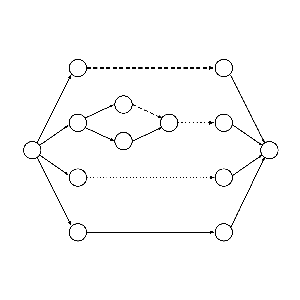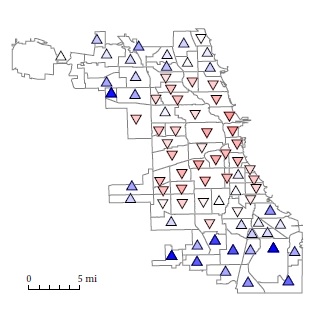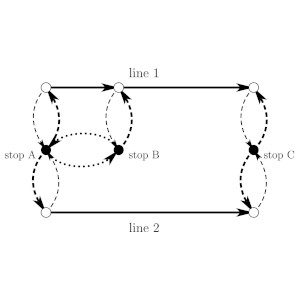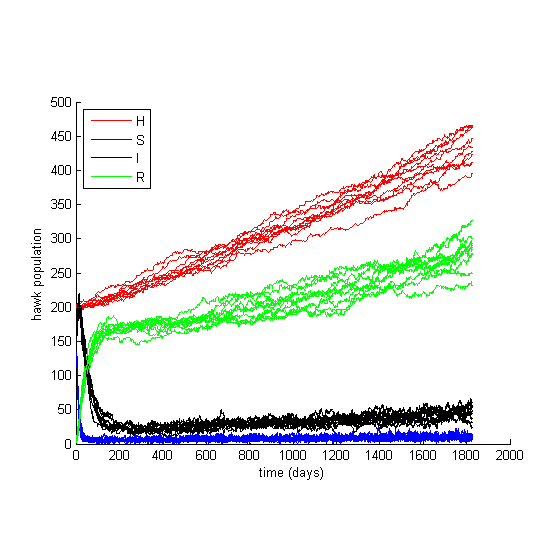
H. Kaul and A. Rumpf. A linear input dependence model for interdependent networks. European Journal of Operational Research, 302(2):781—797, 2022, doi:10.1016/j.ejor.2022.01.020.
Links: Online Article, arXiv Preprint, Source Code, Raw Data
This page contains links to my research papers and related material, including computer code, most of which is available through my GitHub account. I have also included some guides and minor technological resources created for my own personal use while working on projects. You may find them useful in your own research, or as a brief introduction to a topic.

H. Kaul and A. Rumpf. A linear input dependence model for interdependent networks. European Journal of Operational Research, 302(2):781—797, 2022, doi:10.1016/j.ejor.2022.01.020.
Links: Online Article, arXiv Preprint, Source Code, Raw Data

A. Rumpf and H. Kaul. A public transit network optimization model for equitable access to social services. In Equity and Access in Algorithms, Mechanisms, and Optimization (EAAMO'21), October 5—9, 2021. Association for Computing Machinery, New York, NY, doi:10.1145/3465416.3483288.
Links: Online Article, arXiv Preprint, Source Code Directory, Raw Data

A. Rumpf. Mathematics of Civil Infrastructure Network Optimization. Ph.D. Thesis, Illinois Institute of Technology, 2020.
Links: ProQuest

J. Ames, A. Feiler, G. Mendoza, A. Rumpf, and S. Wirkus. Determination of Tucson, Arizona as an Ecological Trap for Cooper's Hawks (Accipiter cooperii). 2011, https://qrlssp.asu.edu/2011-2.
Links: PDF, Source Code
Trilevel Network Interdiction Game for the Minimum Cost Flow Problem with Input Dependence. Joint work with Hemanshu Kaul. 2025 INFORMS Annual Meeting poster, Atlanta, GA, October 26—29, 2025.
Links: PDF
Spatial and temporal accessibility of pharmacies and urgent care in Polk County, Florida. Joint work with Susan LeFrancois and Madison Yonash. Research Day poster, Florida Polytechnic University, Lakeland, FL, April 21, 2025.
Links: PDF
Trilevel Network Interdiction Game for the Minimum-Cost Flows Problem with Interdependent Networks. Joint work with Hemanshu Kaul. 44th Annual Suncoast Regional MAA Meeting, Florida Polytechnic University, Lakeland, FL, December 2, 2022.
Links: Program
Optimization-based models for interdependent civil infrastructure networks. Joint work with Hemanshu Kaul. Applied Mathematics Seminar, Florida Polytechnic University, Lakeland, FL, October 4, 2022.
Links: Abstract
A public transit network optimization model for equitable access to social services. Joint work with Hemanshu Kaul. Equity and Access in Algorithms, Mechanisms, and Optimization (EAAMO'21), Virtual, October 5—9, 2021.
Links: Video
Linear input dependence model for interdependent civil infrastructure systems with network simplex based solution algorithm. Joint work with Hemanshu Kaul. 31st Midwestern Conference on Combinatorics and Combinatorial Computing (MCCCC31), University of West Georgia, Carrollton, GA, October 20—22, 2017.
Network simplex based algorithm for the minimum cost flow problem with linear interdependencies. Joint work with Hemanshu Kaul. Chicago Area SIAM Student Conference 2016 (CASSC 2016), University of Illinois at Chicago, IL, April 16.
Included below is a collection of small programs and technical reports that I've written for my own use over my years of working in operations research. The reports are mostly taken from my personal notes and include some basic overviews and specific technique explanations from operations research, but hopefully someone may find them useful.
Coming up with ideas for research projects is a lot of work. Click the handy button below to generate a random project idea!
Project idea:
PyNETGEN (2022)
Links: PyPI Package, GitHub Repository
This is a Python package for generating random instances of network flows problems (minimum-cost flow and maximum flow) for use in testing and benchmarking. As of the initial release it includes two network generation methods: NETGEN, a widely-used random network generator that I've used in my previous research, and a grid-based algorithm which I plan to make use of in the near future.
MATLAB/SciPy Examples (2022)
Links: GitHub Repository
This is a collection of example scripts demonstrating how to convert a MATLAB program into an equivalent Python program through the use of some popular scientific computing packages, notably SciPy, NumPy, and Matplotlib. Several of these packages include modules specifically meant to make it easy to transition from MATLAB to Python by providing MATLAB-like syntax for working with vectors, matrices, and plots. This collection is primarily aimed at STEM students and professionals whom find themselves in the situation that I was in near the beginning of graduate school: Being used to using a commercial package like MATLAB, but wishing to transition into a fully-fledged programming language.
TeX Untag (2021)
Links: PyPI Package, GitHub Repository
This is a Python package containing a small script for removing all of a given LaTeX markup tag (for example, \textit{...} or \textcolor{red}{...}) from a given file or set of files. I originally wrote it for my own use in preparing a paper for resubmission to a journal, so that I could highlight edits in red in one copy and then submit a clean source file.
EJOR BibTeX Style (2021)
Links: CTAN Package, GitHub Repository
This is a BibTeX style file that I wrote while in the process of editing a paper to submit to the European Journal of Operational Research. Their style guide involves a bibliography style that is close to, but not quite, APA style (for some reason). Rather than just typing in a couple dozen bibliography entries by hand, and in spite of the warnings of the LaTeX Stack Exchange community, I decided it would be a productive use of time to spend a day and a half learning how to write .bst scripts (kind of). Having put in all that work I decided to upload it to CTAN on the off chance that someone else could make use of it.
LaTeX Math Preamble (2019)
Links: TeX Files
This is a TeX file that I typically include in the preamble to all of my mathematical documents. It imports most of the packages that I regularly use and defines a large number of custom macros for mathematical notation that is not part of most standard LaTeX packages. The entire file is likely to be overkill for most simple applications, but feel free to just copy and paste individual portions that you find useful.
Introduction to Simulated Annealing and Tabu Search (2019)
Links: PDF
This is a brief introduction to the simulated annealing and tabu search metaheuristics. I wrote these notes in preparation for my second major research project, which involved solving a difficult combinatorial optimization problem with a hybrid simulated annealing/tabu search algorithm.
Overview of Dual Ascent (2019)
Links: PDF
This is a brief introduction to the dual ascent method for nonlinear optimization (as well as the subgradient), which is closely related to the KKT conditions (see below). The one-sentence summary is that dual ascent consists of performing gradient ascent on the Lagrangian dual, and because the Lagrangian dual is always a concave maximization problem, this is in a very broad sense "easy" as optimization problems go. These notes were written in general preparation for my Ph.D. research since there are some particularly effective dual ascent approaches to network flows problems, although I did not end up actually requiring them in my projects.
Introduction to the Karush-Kuhn-Tucker (KKT) Conditions (2018)
Links: PDF, Mathematica Notebook, Wolfram Demonstration
I wrote these notes for myself while studying the bilevel programs that came out of several of my Ph.D. research projects, since the KKT conditions can be used to rewrite the lower-level program as a set of algebraic constraints in the upper-level program. They are an important concept in nonlinear optimization, and hopefully these notes will provide a brief introduction. The linked Mathematica files were written in conjunction with these notes, and provide some useful pictures to go along with them.
Logical Constraint IP Formulation Techniques (2017)
Links: PDF
These are some techniques that I've written up for expressing logical constraints (of forms like "if constraint 1 is true, then constraint 2 must be true") as integer program constraints. I have used these types of techniques extensively in the process of using mixed integer-linear program models of decision problems.
Getting Started with CPLEX in C++ (2016)
Links: PDF
I wrote this guide for myself while first getting CPLEX set up on my computer for use in my linear optimization projects. It is a complicated enough process that I had to spend many hours searching through forums and blogs to figure it out. Hopefully this can save someone some time.